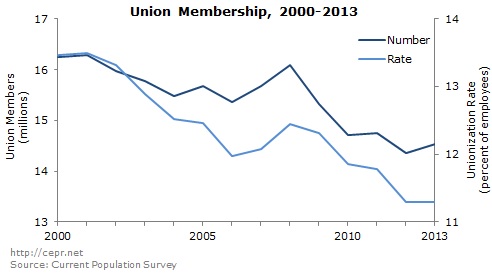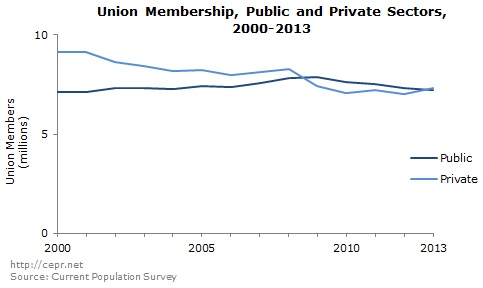Welcome to DU!
The truly grassroots left-of-center political community where regular people, not algorithms, drive the discussions and set the standards.
Join the community:
Create a free account
Support DU (and get rid of ads!):
Become a Star Member
Latest Breaking News
General Discussion
The DU Lounge
All Forums
Issue Forums
Culture Forums
Alliance Forums
Region Forums
Support Forums
Help & Search
General Discussion
Related: Editorials & Other Articles, Issue Forums, Alliance Forums, Region ForumsUnion Membership, 2013
Union Membership, 2013
Written by Janelle Jones and John Schmitt
The number of union members rose 162,000 in 2013, reflecting a drop of 118,000 in the public sector that was offset by a rise of 281,000 in the private sector. Expressed as a share of the workforce, the union membership rate was unchanged in 2013, at 11.3 percent.
In 2013, the share of public-sector workers who were in a union decreased by 0.6 percentage points, from 35.9 percent in 2012 to 35.3 percent in 2013. In the private sector, the unionization rate did not change significantly, increasing from 6.6 percent in 2012 to 6.7 percent in 2013.

<...>
The broad industry categories with the largest increases in union membership were construction (up 95,000) and manufacturing (up 93,000), particularly durable goods manufacturing (up 53,000). By occupation, the aggregate “service occupations,” which includes jobs in health-care support, protective services, food preparation, office cleaning, and personal care, saw an increase in union membership of 85,000. Within this group, the largest union membership increases were in food preparation and serving related occupations (up 43,000) and health-care support occupations (up 37,000).
For the first time since 2008, the total number of union members in the private sector (7.3 million) was higher than the total number of workers in the public sector (7.2 million).

- more -
http://www.cepr.net/index.php/blogs/cepr-blog/union-membership-2013
Written by Janelle Jones and John Schmitt
The number of union members rose 162,000 in 2013, reflecting a drop of 118,000 in the public sector that was offset by a rise of 281,000 in the private sector. Expressed as a share of the workforce, the union membership rate was unchanged in 2013, at 11.3 percent.
In 2013, the share of public-sector workers who were in a union decreased by 0.6 percentage points, from 35.9 percent in 2012 to 35.3 percent in 2013. In the private sector, the unionization rate did not change significantly, increasing from 6.6 percent in 2012 to 6.7 percent in 2013.

<...>
The broad industry categories with the largest increases in union membership were construction (up 95,000) and manufacturing (up 93,000), particularly durable goods manufacturing (up 53,000). By occupation, the aggregate “service occupations,” which includes jobs in health-care support, protective services, food preparation, office cleaning, and personal care, saw an increase in union membership of 85,000. Within this group, the largest union membership increases were in food preparation and serving related occupations (up 43,000) and health-care support occupations (up 37,000).
For the first time since 2008, the total number of union members in the private sector (7.3 million) was higher than the total number of workers in the public sector (7.2 million).

- more -
http://www.cepr.net/index.php/blogs/cepr-blog/union-membership-2013
Private-Sector Union Membership Grows in 2013, but Attacks on Public Employees Take Toll
Mike Hall
The number of workers in unions in 2013 rose by 162,000, with the increase of 281,000 workers in private-sector unions offset by the decrease of 118,000 public-sector union members, according to figures released this morning by the U.S. Bureau of Labor Statistics (BLS).
There were strong gains in construction and manufacturing, against a background of strike actions by low-wage workers in the private sector. But destructive, politically motivated layoffs of public-sector workers continued to hurt overall public-sector union membership, leaving the total percentage of the workforce that is unionized virtually unchanged. Said AFL-CIO President Richard Trumka:
Workers in the public sector continued to bear the brunt of the continuing economic crisis, weak labor laws and political assaults on their rights on the job. In Wisconsin, political attacks on public-sector workers’ right to collectively bargain resulted in bargaining coverage falling. Broadly, federal, state and local governments continued to lay off needed public workers, leading to an overall loss of 118,000 union members.
Secretary of Labor Thomas Perez said the figures again show that union members continue to have higher weekly median earnings than nonunion workers—$950 a week compared to $750 a week. He said union members also have greater access to health care, retirement savings plans, sick and vacation leave than workers who don't have a union on the job.
Trumka said that even with the growth of private-sector union memberships, “Make no mistake, the job of rebuilding workers’ bargaining power and raising wages for the 99% has a long way to go.”
- more -
http://www.aflcio.org/Blog/Organizing-Bargaining/Private-Sector-Union-Membership-Grows-in-2013-but-Attacks-on-Public-Employees-Take-Toll
Mike Hall
The number of workers in unions in 2013 rose by 162,000, with the increase of 281,000 workers in private-sector unions offset by the decrease of 118,000 public-sector union members, according to figures released this morning by the U.S. Bureau of Labor Statistics (BLS).
There were strong gains in construction and manufacturing, against a background of strike actions by low-wage workers in the private sector. But destructive, politically motivated layoffs of public-sector workers continued to hurt overall public-sector union membership, leaving the total percentage of the workforce that is unionized virtually unchanged. Said AFL-CIO President Richard Trumka:
Wall Street’s Great Recession cost millions of America’s workers their jobs and pushed already depressed wages down even further. But in 2013, America’s workers pushed back. At the same time, these numbers show that as unorganized workers have taken up the fight for their right to a voice on the job, union employers are hiring—creating good jobs our economy desperately needs.
Workers in the public sector continued to bear the brunt of the continuing economic crisis, weak labor laws and political assaults on their rights on the job. In Wisconsin, political attacks on public-sector workers’ right to collectively bargain resulted in bargaining coverage falling. Broadly, federal, state and local governments continued to lay off needed public workers, leading to an overall loss of 118,000 union members.
Secretary of Labor Thomas Perez said the figures again show that union members continue to have higher weekly median earnings than nonunion workers—$950 a week compared to $750 a week. He said union members also have greater access to health care, retirement savings plans, sick and vacation leave than workers who don't have a union on the job.
Workers' ability to form unions and engage in collective bargaining has been a cornerstone of a strong middle class. The decline in union membership over the last few decades has contributed to more working families struggling to get by. When workers have a seat at the table, they are better able to bargain for their fair share of the value they helped create; and that leads to greater economic security and economic mobility for everyone. As our economy continues to recover and we work to create good jobs, we need to ensure workers can lift their voices to raise wages, reduce inequality and help more people climb ladders of opportunity.
Trumka said that even with the growth of private-sector union memberships, “Make no mistake, the job of rebuilding workers’ bargaining power and raising wages for the 99% has a long way to go.”
Collective action among working people remains the strongest, best force for economic justice in America. We’re building a stronger, more innovative movement to give voice to the values that built this country. From Walmart workers to fast-food workers to home care workers, the rising up of workers’ voices against inequality—both inside and outside of traditional structures—is the story of 2013.
- more -
http://www.aflcio.org/Blog/Organizing-Bargaining/Private-Sector-Union-Membership-Grows-in-2013-but-Attacks-on-Public-Employees-Take-Toll
InfoView thread info, including edit history
TrashPut this thread in your Trash Can (My DU » Trash Can)
BookmarkAdd this thread to your Bookmarks (My DU » Bookmarks)
5 replies, 1042 views
ShareGet links to this post and/or share on social media
AlertAlert this post for a rule violation
PowersThere are no powers you can use on this post
EditCannot edit other people's posts
ReplyReply to this post
EditCannot edit other people's posts
Rec (7)
ReplyReply to this post
5 replies
 = new reply since forum marked as read
Highlight:
NoneDon't highlight anything
5 newestHighlight 5 most recent replies
= new reply since forum marked as read
Highlight:
NoneDon't highlight anything
5 newestHighlight 5 most recent replies
Union Membership, 2013 (Original Post)
ProSense
Jan 2014
OP
ProSense
(116,464 posts)1. Kick! n/t
ProSense
(116,464 posts)2. Another. n/t
Javaman
(62,528 posts)3. Want to be even more depressed?

ProSense
(116,464 posts)4. Thanks for posting that.
It has been downhill since 1955.
It's going to take years to regain that level, but reversing the state and local public sector job cuts since 2008 will help.
ProSense
(116,464 posts)5. Kick! n/t